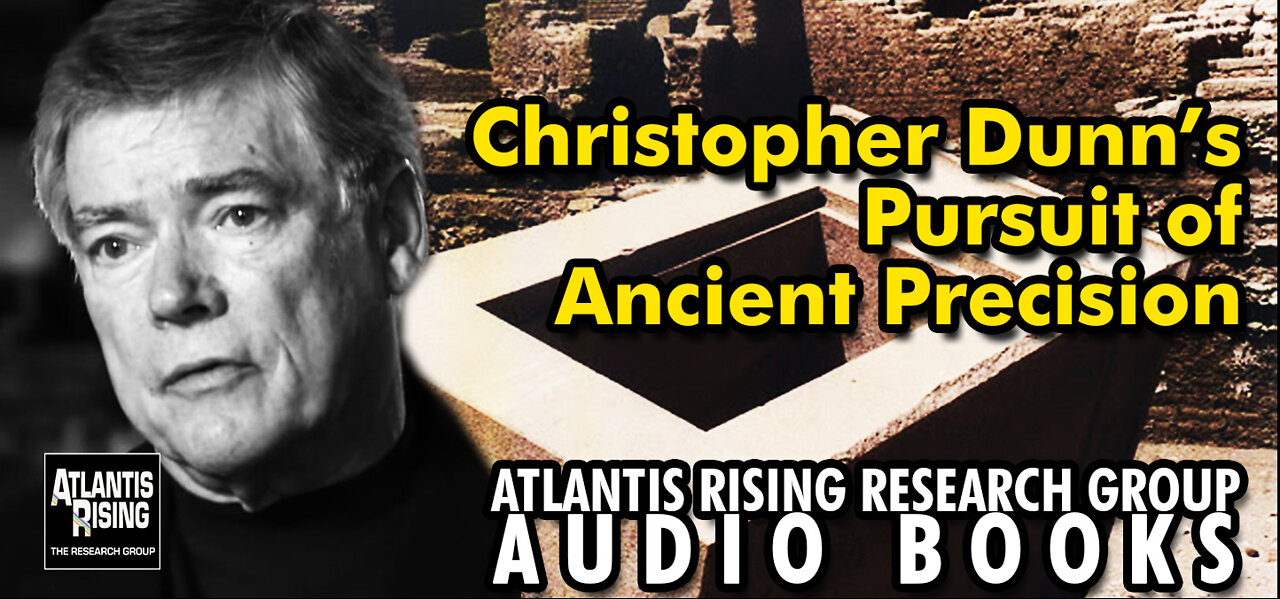Premium Only Content

Christopher Dunn's Pursuit of Ancient Precision - Atlantis Rising Magazine
Visit Atlantis Rising Research Group at https://www.atlantisrising.com/
Christopher Dunn is well known to the readers of Atlantis Rising. His many investigations of the fantastic technologies of the ancients have been among our most popular features and constituted a major part of our bestselling book Forbidden History (Inner Traditions/Bear, 2005). Now Dunn has produced a new book focussing on the extraordinary technical achievements of the ancient Egyptians. What follows is from the foreword by professional engineer Arlan Andrews.—Editor
What researcher Christopher Dunn has accomplished in his new book Lost Technologies of Ancient Egypt (Inner Traditions/Bear, 2010) and in his previous work, The Giza Power Plant, is more than a paradigm shift; it is more of a paradigm seismic event. Because once a person with a manufacturing or machining background—engineer, technician, machinist, artisan—reads and understands what Dunn has discovered and analyzed in ancient Egyptian stonework, that person will never look at ancient Egyptians the same way ever again. That reader will become skeptical of portrayals of ancient Egyptians as primitives in any sense. That reader will begin to analyze every new Egyptian archaeological discovery, to see what else conventional Egyptologists have overlooked. That reader will become part of the new paradigm.
In these pages, Chris Dunn demonstrates an underlying system of incredible precision in the machining, layout, and positioning of both individual objects and groups of features, ranging from the toolmark details in the “Rose Red Rosetta Stone of Abu Roash” to the symmetries of the giant heads of Ramses at the temples in Luxor, to the layout of the column capitals of the Great Hypostyle Hall at Denderah, to the base of the Great Pyramid itself. Thanks to this work, the modern reader sits back in awe and admiration of the Egyptian geniuses of five thousand years ago. The ancient artifacts contain amazing messages, but the stones cannot speak for themselves. This book speaks for them.
In November 2008, I accompanied Mr. Dunn and others to what some have called “the Lost Pyramid” at Abu Roash, some ten kilometers northwest of Giza. I was anxious to see the rose-colored granite piece that the author had described to me years before, and was anticipating seeing the compound radial cuts and distinguishing toolmarks. I was not disappointed. To any technophile, this one cut stone challenges the arguments made for primitive tools and primitive peoples. More than any other artifact, it embodies an ancient “language” that still speaks to modern engineers. I immediately dubbed it “The Rose Red Rosetta Stone of Abu Roash.”
I called the stone a “Rosetta” because its discovery reminded me of another paradigm-changing artifact: in 1799, Napoleon’s soldiers found a curious object embedded in a wall of an Egyptian village. Their original report, “A Report on a Stone Found in the Village of Rosetta,” describes a black rock slab inscribed with three languages, one of them being ancient Greek, the others the unknown Egyptian hieroglyphic writing and the cursive or “demotic” Egyptian writing. Reading the Greek portion, the antiquarian Champollion was able to translate the names of the Pharaohs— written within cartouches—and thence the rest of the hieroglyphic writing itself. He opened up an eventual understanding of the millions of carved figures decorating the ancient temples and tombs of the Nile. Nobody would ever again look at the hieroglyphic carvings as mere magical, mystical figures but would read the translations of experts who deciphered those cuts and reliefs, uncovering the lost history of Egypt.
The Rosetta stone thus facilitated a change in the worldview of moderns who looked back at ancient Egyptians. Nothing would ever be the same. I maintain that this book has accomplished a similar feat, every bit as meaningful to an understanding of ancient Egypt, if not more so. Once understood, Dunn’s discoveries will forever change the perception of the serious researcher.
-
 0:19
0:19
Atlantis Rising Research Group
2 years agoJoin the ATLANTIS RISING RESEARCH GROUP!
1.05K1 -
 LIVE
LIVE
Dr Disrespect
9 hours ago🔴LIVE - DR DISRESPECT - MARVEL RIVALS - RANKED
5,310 watching -
 LIVE
LIVE
The Jimmy Dore Show
2 hours agoPelosi Shivs AOC In Leadership Vote! Poll: 40% Of Young People SUPPORT CEO Murder! w/Leonarda Jonie
14,807 watching -
 2:24:08
2:24:08
WeAreChange
3 hours agoElon Musk & Donald Trump: The Emergency Halt That Saved Us
20.9K8 -
 LIVE
LIVE
Space Ice
6 hours agoSpace Ice & Redeye Try To Figure Out Seagal's Most Incoherent Movie
114 watching -
 1:00:36
1:00:36
PMG
20 hours ago $0.03 earned"Santa Trump is Giving Us Hope - But Will Johnson Stand Strong?"
5542 -
 54:30
54:30
LFA TV
1 day agoThe German Strongman’s Arrival Is Imminent | Trumpet Daily 12.18.24 7PM EST
4.44K -
 2:04:11
2:04:11
Melonie Mac
4 hours agoGo Boom Live Ep 32! Soul Reaver Remastered!
16.5K2 -
 39:11
39:11
Sarah Westall
1 hour agoDigital Slavery and Playing with Fire: Money, Banking, and the Federal Reserve w/ Tom DiLorenzo
8.9K -
 LIVE
LIVE
2 MIKES LIVE
6 hours ago2 MIKES LIVE #157 ILLEGALS, PROTESTORS AND DRONES!
226 watching